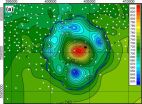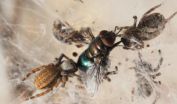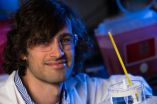(Press-News.org) STANFORD, Calif. — New research could soon make it easier for people with type-1 diabetes to get a safe night's sleep, says a Stanford University School of Medicine scientist who led the study.
In a large trial conducted in patients' homes in the United States and Canada, scientists demonstrated that they could predict and prevent dangerously low overnight blood sugars in adolescents and adults with type-1 diabetes.
Very low blood-sugar levels can cause seizures or even, in rare cases, death. People with type-1 diabetes often sense warning signs of low blood sugar when they are awake, but not during sleep, explaining why 75 percent of diabetic seizures occur at night.
The new study, which will be published online May 7 in Diabetes Care, coupled a glucose sensor worn under the skin to an insulin pump that was connected wirelessly to a computer at the bedside. The computer ran an algorithm that calculated when a low blood-sugar level might occur and then temporarily suspended insulin delivery until the sugar level was trending upward. This occurred without waking the patient. The shutoffs reduced the cumulative time patients spent with low blood sugars during sleep by 81 percent, with only a minimal increase in nighttime glucose levels.
"A system like this should dramatically decrease diabetics' risk of having a seizure overnight," said Bruce Buckingham, MD, professor of pediatric endocrinology at Stanford, who led the trial and is a co-author of the study. "Patients and parents will be able to have a better night's sleep, knowing that there is a much lower risk of severe hypoglcyemia at night." Buckingham is also a pediatric endocrinologist at Lucile Packard Children's Hospital Stanford.
Diabetics who use insulin pumps usually receive a low dose of insulin throughout the night; it is delivered by the pump through a small catheter inserted under the skin. In the past, researchers have tried other approaches to prevent low blood sugar during sleep, such as having glucose sensors trigger an alarm for a low blood-sugar level. This has only been partly successful because patients sleep through about 70 percent of the alarms. Since a person with diabetes would shut off their insulin pump if they had a low blood glucose, the next approach was to use the sensors' glucose values to suspend insulin delivery when low blood glucose was detected.
The new study involved 45 people, ages 15-45, with type-1 diabetes. Each person participated for about 42 nights, for a total of 1,912 nights. The patients slept in their own homes. Their insulin pumps were wirelessly connected to a laptop computer near their beds.
Each night, the algorithm on the computer was randomly assigned to be active or inactive and participants did not know whether the algorithm was active before they went to sleep. On treatment nights, the computer algorithm predicted whether blood sugar would fall below 80 milligrams per deciliter in the next 30 minutes, a threshold slightly above the 60 mg/dl level at which complications of low blood sugar set in. If the computer predicted lows, the subject's insulin pump was shut off until the subject's blood sugar was increasing.
In addition to the 81 percent reduction in time spent with low blood sugar, there were several other indicators that the treatment was useful. The insulin pumps were shut off at least once during 76 percent of the treatment nights, and the time spent in episodes of low blood sugar that lasted two hours or more was reduced by 74 percent.
In the morning, median blood glucose was slightly higher after treatment nights, but still within a safe range. The blood-glucose sensors recorded similar percentages of nights with high blood-glucose values in both treatment and control conditions. Subjects checked their urine and blood each morning for ketones, an indicator of whether their sugar levels had become too high during the night. Ketone levels were similar after control and treatment nights. These results indicated that the insulin pump shutoffs were not putting subjects at risk from high blood sugars.
The research team is now expanding their investigations to a larger age group, including children ages 3-15. "A lot of parents whose children have diabetes are getting up night after night at midnight and 3 a.m. to check their children's blood-sugar levels," Buckingham said. "We think this type of system is going to make it much easier for them to feel comfortable about letting their child with diabetes sleep through the night with fewer overnight sugar tests. Parents will be able to get a better night's sleep, too."
INFORMATION:
In addition to Buckingham, the research team included the study's lead author, David Maahs, MD, PhD, assistant professor of pediatrics at the University of Colorado Anshutz Medical Campus, and senior author Roy Beck, MD, PhD, executive director of the Jaeb Center for Health Research Inc. in Tampa, Fla. Other Stanford co-authors of the study were Tandy Aye, MD, assistant professor of pediatrics, and Darrell Wilson, MD, professor of pediatrics. Aye and Wilson are also pediatric endocrinologists at Lucile Packard Children's Hospital Stanford.
The work was supported by the National Institute of Diabetes and Digestive and Kidney Diseases (grant R01DK085591) and grants from Juvenile Diabetes Research Foundation and the foundation's Canadian Clinical Trial Network.
Continuous glucose monitors and sensors were purchased at a bulk discount price from Medtronic MiniMed Inc. Home glucose meters and test strips, as well as ketone meters and test strips, were provided to the study by LifeScan Inc. and Abbott Diabetes Care Inc. These companies had no involvement in the design, conduct or analysis of the trial or the manuscript preparation. In disclosing potential conflicts of interest, Buckingham, Wilson and others on the research team report patent pending on a Kalman-filter-based hypoglycemia prevention algorithm. Several of the researchers report relationships with Medtronic MiniMed: grants to two researchers, including Buckingham; research supplies to Wilson; board memberships by two researchers; and consultant fees to one researcher. Maahs reports grants from American Diabetes Association-Medtronic. Wilson and Buckingham have received research supplies support from Lifescan Inc.
PRINT MEDIA CONTACT: Erin Digitale at (650) 724-9175 (digitale@stanford.edu)
BROADCAST MEDIA CONTACT: Winter Johnson at (650) 498-7056 (wijohnson@lpch.org)
(NOTE TO REPORTERS: Participants from this study are available to interview.)
The Stanford University School of Medicine consistently ranks among the nation's top medical schools, integrating research, medical education, patient care and community service. For more news about the school, please visit http://mednews.stanford.edu. The medical school is part of Stanford Medicine, which includes Stanford Hospital & Clinics and Lucile Packard Children's Hospital. For information about all three, please visit http://stanfordmedicine.org/about/news.html.
Stanford Children's Health, with Lucile Packard Children's Hospital Stanford at its core, is an internationally recognized leader in world-class, nurturing care and extraordinary outcomes in every pediatric and obstetric specialty from the routine to rare, for every child and pregnant woman. Together with our Stanford Medicine physicians, nurses, and staff, we deliver this innovative care and research through partnerships, collaborations, outreach, specialty clinics and primary care practices at more than 100 locations in the U.S. western region. As a non-profit, we are committed to supporting our community – from caring for uninsured or underinsured kids, homeless teens and pregnant moms, to helping re-establish school nurse positions in local schools. Learn more about our full range of preeminent programs and network of care at stanfordchildrens.org, and on our Healthier, Happy Lives blog. Join us on Facebook, Twitter, LinkedIn, and YouTube.
Lucile Packard Children's Hospital Stanford is the heart of Stanford Children's Health, and is one of the nation's top hospitals for the care of children and expectant mothers. We are the only children's hospital in Northern California with specialty programs ranked in the U.S. News & World Report Top 10 for 2013-14, and the only hospital in Northern California to receive the national 2013 Leapfrog Group Top Children's Hospital award for quality and patient care safety. Discover more at stanfordchildrens.org.
For slumbering diabetics, a way to detect low blood sugar and stop insulin delivery
2014-05-07
ELSE PRESS RELEASES FROM THIS DATE:
Ancient crater points to massive meteorite strike
2014-05-07
EDMONTON—The discovery of an ancient ring-like structure in southern Alberta suggests the area was struck by a meteorite large enough to leave an eight-kilometre-wide crater, producing an explosion strong enough to destroy present-day Calgary, say researchers from the Alberta Geological Survey and University of Alberta.
The first hints about the impact site near the southern Alberta hamlet of Bow City were discovered by a geologist with the Alberta Geological Survey and studied by a U of A team led by Doug Schmitt, Canada Research Chair in Rock Physics.
Time and glaciers ...
Mapping the spider genome
2014-05-07
The fact that the eight-legged creepy spider in some ways resembles humans is one of the surprising conclusions after researchers at Aarhus University and the Beijing Genomics Institute (BGI) succeeded in sequencing its genome.
However, it is more a discovery on an awesome scale. The sequencing has far greater significance for our future understanding of the spider's special properties.
"In brief, we've acquired a tool for everyone interested in spiders," say Kristian W. Sanggaard and Jesper S. Bechsgaard, Aarhus University. Together with Xiaodong Fang, BGI, they are ...
Neural states affect learning
2014-05-07
Theta-band activity in hippocampus after an event seems to be crucial for learning. A study at the University of Jyväskylä also proved that the absence of theta facilitated learning a simple task while training during theta had no effect on learning.
Hippocampus is a brain structure that has a critical role in mammalian learning. The identification of different hippocampal states is based on the oscillatory properties of electrophysiological activity. Traditionally, rhythmic slow activity, theta, has been linked to attention, whereas transient bursts of synchronised neuronal ...
Third US National Climate Assessment reports our ecosystems are already changing
2014-05-07
The US Global Change Research Program released its Third National Climate Assessment (NCA) of the impacts of climate change on biodiversity and ecosystems this Tuesday, May 6. The NCA is the most comprehensive peer-reviewed analysis of climate change's impacts in the United States, informing Americans about the effects of climate change in their backyards.
"As an ecologist, you can't escape the effects of climate change on natural resources. We're observing climate impacts in nearly all natural and managed ecosystems," said Ecological Society of America President Jill ...
Breastfeeding promotes the growth of beneficial bacteria in the gut
2014-05-07
A number of studies have shown that breastfed babies grow slightly slower and are slightly slimmer than children who are fed with infant formula. Children who are breastfed also have a slightly lower incidence of obesity, allergies, diabetes and inflammatory bowel disease later in life. According to a new study by the National Food Institute and the University of Copenhagen this may be due to the fact that breastfeeding promotes the development of beneficial bacteria in the baby's gut.
"We have become increasingly aware of how crucially important a healthy gut microbial ...
Nanoscale heat flow predictions
2014-05-07
Physicists are now designing novel materials with physical properties tailored to meet specific energy consumption needs. Before these so-called materials-by-design can be applied, it is essential to understand their characteristics, such as heat flow. Now, a team of Italian physicists has developed a predictive theoretical model for heat flux in these materials, using atom-scale calculations. The research, carried out by Claudio Melis and colleagues from the University of Cagliary, Italy, is published in EPJ B. Their findings could have implications for optimising the ...
Researchers use DNA to build tool that may literally shine light on cancer
2014-05-07
Bioengineers at the University of Rome Tor Vergata and the University of Montreal have used DNA to develop a tool that detects and reacts to chemical changes caused by cancer cells and that may one day be used to deliver drugs to tumor cells.
The researchers' nanosensor measures pH variations at the nanoscale – how acidic (a higher pH level) or alkaline (a lower pH level) it is. Many biomolecules, such as enzymes and proteins, are strongly regulated by small pH changes. These changes affect in turn biological activities such as enzyme catalysis, protein assembly, membrane ...
Sleep researchers at SRI International identify promising new treatment for narcolepsy
2014-05-07
MENLO PARK, Calif.—May 7, 2014—Neuroscientists at SRI International have found that a form of baclofen, a drug used to treat muscle spasticity, works better at treating narcolepsy than the best drug currently available when tested in mice.
According to the National Institute of Neurological Disorders and Stroke (NINDS), narcolepsy, a chronic neurologic disorder characterized by excessive daytime sleepiness, is not a rare condition, but is under-recognized and under-diagnosed. It is estimated to impact 1 in 2,000 people worldwide.
In back-to-back papers published in ...
Argentina yields 3 new tarantula species
2014-05-07
A team of scientists from the Universidad de La República, Uruguay discovered three native to northern Argentina new species of the engaging spider group of the tarantulas. The study describing the newly found tarantulas was published in the open access journal ZooKeys.
The often hairy and very large spiders known as tarantulas are one of the most famous arachnid groups. Despite their ill fame as vicious killers most tarantulas are harmless to humans. Most tarantulas long lifespans, females can live between 15 and 30 years, which makes them a preferred pet for spider ...
A hydrogel that knows when to go
2014-05-07
HOUSTON – (May 7, 2014) – Rice University bioengineers have created a hydrogel that instantly turns from liquid to semisolid at close to body temperature – and then degrades at precisely the right pace.
The gel shows potential as a bioscaffold to support the regrowth of bone and other three-dimensional tissues in a patient's body using the patient's own cells to seed the process.
The hydrogel created in the lab of Rice bioengineer Antonios Mikos is a liquid at room temperature but, when injected into a patient, becomes a gel that would fill and stabilize a space while ...




